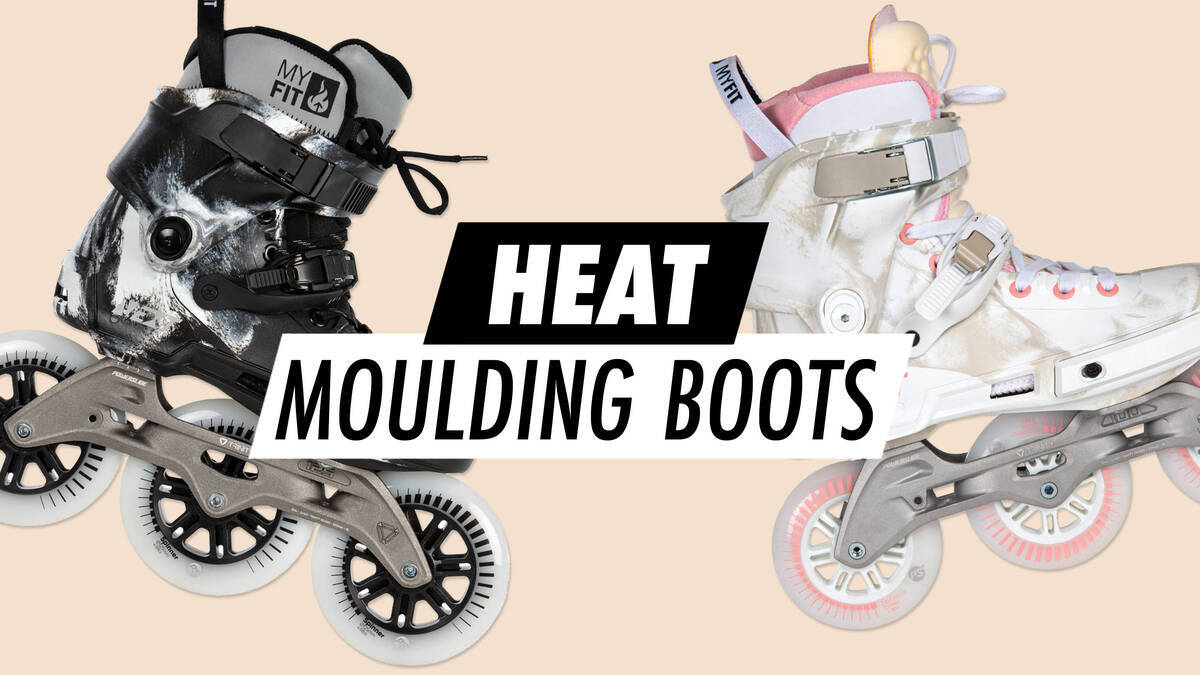Heating and Moulding Powerslide Boots: A Guide


Thermo Forming of Boots

SHMR-Technology Explained
SHMR, standing for Super Heat Mouldable Resin, represents a technological advancement in contemporary racing footwear. It involves a distinctly different shell construction compared to boots utilising thermo sheets. A unique heat mouldable epoxy is employed to integrate various layers of carbon fibre. Due to the epoxy present throughout and between all layers of carbon fibre, racing shoes with SHMR-Technology can be heat moulded at any point on their shell. Moreover, the epoxy can be remoulded repeatedly without the risk of losing its functionality. The optimal moulding temperature for these racing shoes, incorporating SHMR-Technology, is around 80-90 degrees Celsius, which is comparatively low. A further benefit of using SHMR is the slight reduction in the shell's weight.
The racing shoes listed below incorporate the innovative SHMR Technology:
- Powerslide: Double X, Vision, Vision Junior, Infinity, C8, PH9
- Core Racing: Vi-Pro, Icon, Triple X2
Thermo Sheets: The Classic Approach
This "old school" method remains prevalent in the majority of heat mouldable speed boots. Thermo sheets consist of thin, heat mouldable composite layers nestled within the carbon layers of the shell. Historically, thermo sheets have been concentrated around the boot's ankle area. Consequently, moulding is feasible only in the thermo sheet-laden areas, due to carbon fibre's absence of heat mouldable properties.
Thermo sheets' downside: after repeated heating, the material becomes brittle, limiting the moulding process. They are not utilised whatsoever in either Powerslide or Core Racing footwear.
How to Properly Heat Mould Your Skates
Thanks to our advanced SHMR technology—also known as Super Heat Moulding Technology—all Powerslide and Core Racing carbon boots are entirely heat mouldable. For optimal results, adhere to the following steps. Use either an oven or a heat gun for heat moulding your boots.
Important Notice! The shell can be moulded at any location. It is advisable to keep the frame on the boots and to wear them while sitting. Do not stand with your full weight on the skates during the heat moulding process!
- Take off the wheels and undo the laces and buckles
- Preheat the oven to 80°C - 90°C
- Position the boot in the centre of the oven
- Allow the boot to remain for roughly 10-15 minutes until the cuff area becomes pliable
Warning: Avoid inserting your foot into a hot boot to prevent burns! Similarly, metal buckles or eyelets might cause finger burns!
- Allow the boot to cool slightly and check the temperature with your finger before stepping in
- Fasten the laces and buckles
- Ensure your leg maintains the correct skating stance
- Wait for the boot to cool
- Use the plastic end of a screwdriver to press out any areas causing discomfort
- Repeat the process for the other boot
If the outcome is not satisfactory, you may heat mould your boots as often as needed.
Warning: When employing a heat gun, maintain a safe distance of approximately 20 cm from the upper leather to prevent material damage.
What Speed Boots Can Be Heat Moulded?
Most brands provide heat mouldable speed boots. Enquire with your local retailer or the manufacturer to determine if they use "thermo sheets" in the carbon fibre boots or a similar technology like the one applied in Powerslide and Core Racing shoes. Bear in mind, carbon fibre in itself cannot be heat moulded. Moulding requires a layer of specific material. The exceptional SHMR Technology used in Powerslide and Core Racing carbon fibre shoes is an exception to this.
Unlimited Heat Moulding with SHMR Technology
With SHMR technology, you can repeat the process as often as desired.
Boots incorporating thermo sheets become less robust after multiple moulding sessions. It is advisable to mould only when necessary. If fit issues persist despite heat moulding, it might be worth considering custom boots.
Understanding Extended Softening Time in Powerslide and Core Racing Shoes
The reason lies in the quality of the epoxy used for shell production. Poor quality epoxy softens at lower temperatures, making the shell easier and faster to soften. Although some skaters view this positively, the opposite is true. All Powerslide and Core Racing shoes utilise only high-quality epoxy, requiring higher temperatures to liquefy the epoxy, thus extending the shell softening time.
Shoes with shells softening at low temperatures could inadvertently get moulded if exposed to direct sunlight, such as in a truck or car.
